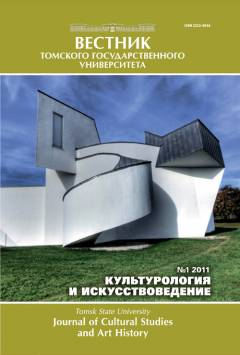Reflection of modernist architectural-artistic concepts in minimalist architecture
People started talking about the architecture of minimalism as about an established phenomenon at the middle of the 80s. At that exact time its basic stylistic (recognizable) features manifested themselves: emptiness, simplicity and space. The authentic architectural and artistic features of a minimalist architecture include: 1) a unified, repressed internal space and an external monolithic, strict and unified form of the building; 2) light and monochrome / neutral color; 3) emptiness, severity and simplicity; 4) homogeneity of surfaces and lack of details; 5) modern advanced construction technologies, high-quality modern materials; 6) innovations in the technical equipment of the building; 7) the implementing of a natural environment inside the construction. There are most significant architectural and artistic ideas embodied in the minimalist architecture: the concept of simplicity and emptiness, the concept of a unified space, the concept of the implementing of a natural environment into architecture. They clearly have a visual analogy to similar ideas of modernism. Using the concepts of modernism (emptiness and simplicity, a unified space, connection with nature) for minimalist architects has become a genetically natural phenomenon. It is confirmed in the studies of M. Grimshaw, I. Ruby, A. Ruby, A. Sachs, P. Ursprang, J. MacArthur, H. Ibelinges, C. Jenks, who view Architectural Minimalism as part of a general phenomenon - Architectural Modernism in its evolution . The genetic connection of minimalism with the architecture of modernism allowed the author to interpolate between modernist ideas and their representation in minimalist architecture. Therefore, the subject of research in this article are the leading concepts of architectural modernism, which are reflected in architectural minimalism. The article analyzes the main ideas of modernist architecture that have influenced architectural minimalism on the example of suburban housing of a wealthy class. The concept of emptiness and simplicity was realized in modernism through sterile empty space, space of simple forms, space without details. Further, it was developed in minimalism and represented through tactile empty space and space of absolute emptiness (invisibility and masking of elements of architecture and furniture). The concept of a single space in modernism was implemented through a fluent lay-out that allowed to get rid of not only the bearing walls, but also of partitions in general, through the simplification of functional links, the unifying of zones. In minimalism, this led to the usage of an undivided, universal space in the design of public buildings, and to the absence of partitions in the day / secular part in the housing. The concept of connection with nature was solved by modern architects through merging with the natural environment due to large glazing surfaces (ribbon glazing, glass partitions), through the "implantation" of nature into the house - the "roof garden". The minimalist architects implemented the idea of a connection with nature with the glass partitions and the presence of a garden yard or courtyard.
Keywords
минималистическая архитектура, архитектурный минимализм, архитектурный модернизм, модернистская архитектура, черты архитектурного минимализма, архитектурные модернистские концепции и идеи, minimalist architecture, architectural minimalism, modernism, modernist architecture, characteristics of an architectural minimalism, modernist ideasAuthors
| Name | Organization | |
| Gudkova Tatyana V. | Novosibirsk State University of Architecture, Design and Arts | t.v.gudkova@gmail.com |
References

Reflection of modernist architectural-artistic concepts in minimalist architecture | Tomsk State University Journal of Cultural Studies and Art History. 2017. № 27. DOI: 10.17223/22220836/27/2